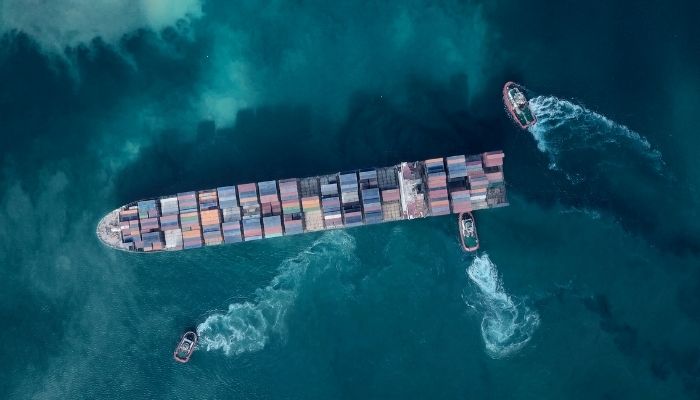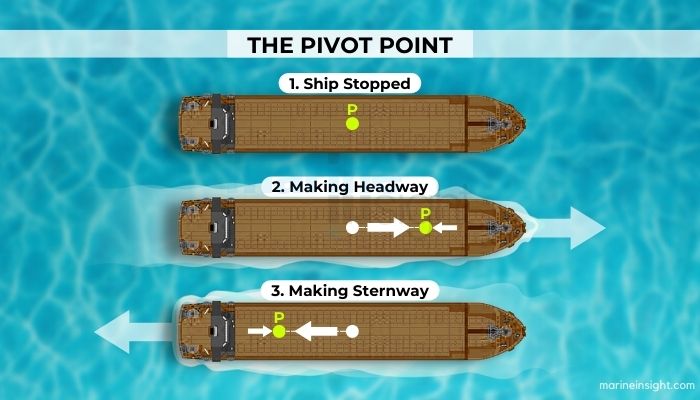Manoeuvring is the ability of a vessel to turn towards the port or starboard side using the steerage force stemming from the turning of the rudder aft based on diverse requirements.
These requirements can be anything like maintaining or changing its desired course of travel, trying to steer clear of an obstruction underway, or approaching a port or dock.
Manoeuvring is a broad topic in naval architecture or vessel sciences and has been a matter of serious discussion and research for years. Many of us are also aware of the manoeuvring trials that take place to assess the turning abilities of a vessel.
Before discussing the pivot point of a vessel, it is crucial to revisit a ship’s ‘turning circle’ manoeuvre briefly.
A turning circle manoeuvre is when the vessel constantly turns towards a particular direction such that it completes or tends to complete a full circle after some time and returns to its origin or starting point.
This is a common aspect of transportation, starting from vehicles like cars or two-wheelers. Similarly, a turning circle is achieved for vessels by simply applying the constant rudder moment towards a particular side.
For example, by applying the rudder angle towards the port side, a vessel turns leftwards and essentially tends to complete a turning circle in an ‘anticlockwise sense.’ Likewise, by applying a rudder angle towards the starboard, the vessel tends to achieve a turning circle in a ‘clockwise sense.’

Simply put, a turning circle is nothing but a vessel turning in a particular direction. The constant turning moment from the rudder is applied for a fair amount of time to develop a motion in a circular trajectory or path.
Hence, we can all say that when a vessel turns towards a particular side, even for less time, it marks the beginning of the turning circle phenomena. The turning tendency is stopped whenever the rudder is re-aligned, and the vessel re-orients itself to the new direction or course.
Other kinds of nuances and physical phenomena are involved in this. For instance, for a starboard turn, during some initial moments, the vessel tends to drift slightly towards the port side before re-orienting towards the intended starboard direction and vice-versa. This is due to the interplay of some hydrodynamic phenomena.
Moving back to the physics of turning, there are essentially three phases of turning:

i) The first, where the rudder force is applied, the vessel tends to initially drift towards the other side and finally attains an equilibrium of forces and moments involved in turning towards the desired course.
ii) the second phase, where the vessel is at 90 degrees from its original direction of heading, and the moments from the induced one of the rudder and the hull are in a state of mutual equilibrium. During this stage, the centrifugal force also comes into action, keeping the vessel oriented towards the geometric centre of the circle it traces or tends to trace.
iii) In The third phase, where a steady state is achieved, the trajectory becomes fixed with a constant radius, and all external forces become virtually non-existent, with the hull moment becoming the dominant one exceeding the induced moment of the rudder.
Now, whenever a vessel is in a state of turn, irrespective of whether it completes a turning circle, the turning takes about a point of action. As we know from the physics of rotation, all bodies in a state of rotatory motion turn about to a fixed point within the geometric limits of the body.
What is a pivot point of a vessel?
This is the same for vessels, where during stages of turning, the vessel’s turning moment acts about a definitive point of action, which lies on its centre-line, somewhat towards the fore-end or aft end. This kinematic point of action is known as the pivot point of a vessel.
In simple words, it can also be imagined as the point of rotation of a vessel. Now, since the hull is never a regular-shaped body, this pivot point is never the same as the Centre of Gravity, or C.G of the vessel, about which we have dealt with so much in the entire field of naval architecture or marine sciences.
Neither is it related to the Centre of Flotation or Centre of Buoyancy, which is related to the disposition of the vessel on the water surface and the overall hydrostatics associated with the hull.
However, the pivot point is more of a hydrodynamic parameter. The pivot point’s position primarily depends on the hull form, the speed, and the direction of the vessel’s motion. Though different, it is up to some extent on these mentioned points as well, the correlation being beyond the scope of this article.
Though we mentioned just a while back that it is a ‘fixed’ point, the fixity is only relevant for a particular scenario, and the location of this point may change again for a different speed-motion scenario.
For example, for all practical purposes, this point is located between 1/3rd and 1/6th of the bow when the vessel is moving ahead or has a forward component of speed and around 1/3rd or 1/6th of the stern when the ship is moving astern.
Now, let us discuss some instances to know more about the positions of the pivot point in detail based on the situation.
Most designers use the ratio velocity by length or V/L as a parameter for analysing the behaviour of the pivot points.
- When the vessel is stationary (V/L=0): There are no forces or motions associated with the vessel. The pivot point is almost close to or coinciding with the C.G, which is near the midship.
- When the vessel moves ahead (V/L >0): The pivot point shifts forwards and is roughly located around 1/3rd or 1/4th distance from the bow, as mentioned.
- When the vessel is moving backwards (V/L <0): The pivot points move backwards and, similarly, are located around 1/3rd to 1/4th of the ship’s length from the stern, depending on the speed.
- When the vessel is turning: When the vessel is turning either by bow or stern, the pivot point attains a location somewhere between 1/3rd and 1/6th of the vessel’s length from bow or stern, depending on the hull form, speed and rudder moment applied. The location of the pivot point determines the radius of the circle completed or tended during turning. A smaller circle is achieved if the pivot point is closer to the bow or stern, for forward or back turning, respectively. For the pivot point further from the bow, the circle is larger. In terms of hull form, a fuller form ship, like a bulker or tanker, has a pivot point closer to the bow than slender vessels.
The locus of the pivot point traced during turning is the trajectory of the circle created or tending to be created.
